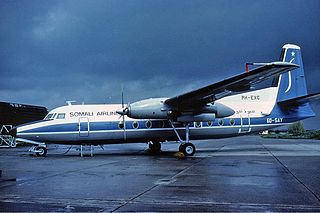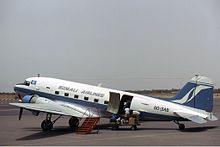Kenya Airways Ltd., more commonly known as Kenya Airways, is the flag carrier airline of Kenya. The company was founded in 1977, after the dissolution of East African Airways. Its head office is located in Embakasi, Nairobi, with its hub at Jomo Kenyatta International Airport.
Ariana Afghan Airlines Co. Ltd., also known simply as Ariana, is the flag carrier and largest airline of Afghanistan. Founded in 1955, Ariana is the oldest airline in the country and is state owned. The company has its main base at Kabul International Airport, from which it operates domestic flights and international connections to destinations in China, India, Pakistan, Russia, Saudi Arabia, Turkey, and the United Arab Emirates. The carrier is headquartered in Shāre Naw district, Kabul. Ariana Afghan Airlines has been on the list of air carriers banned in the European Union since October 2006.
Pakistan International Airlines is an international airline that serves as the flag carrier of Pakistan under the administrative control of the Secretary to the Government of Pakistan for Aviation. Its central hub is Karachi's Jinnah International Airport, while Allama Iqbal International Airport in Lahore and Islamabad International Airport serve as secondary hubs.

Libyan Airlines, formerly known as Libyan Arab Airlines over several decades, is the flag carrier of Libya. Based in Tripoli, it operates scheduled passenger and cargo services within Libya and to Europe, North Africa and the Middle East, the majority of which leave from Tripoli International Airport. Benina International Airport in Benghazi serves as a secondary base. Libyan Airlines also operates Hajj services. The company is wholly owned by the government of Libya.
Tunisair is the national airline of Tunisia. Formed in 1948, it operates scheduled international services to four continents. Its main base is Tunis–Carthage International Airport. The airline's head office is in Tunis, near Tunis Airport.
Sudan Airways is the national airline of Sudan, headquartered in Khartoum. Since 2012, the company has been fully owned by the Government of Sudan.

Air Namibia (Pty) Limited, which traded as Air Namibia, was the national airline of Namibia, headquartered in the country's capital, Windhoek. It operated scheduled domestic, regional, and international passenger and cargo services, having its international hub in Windhoek Hosea Kutako International Airport and a domestic hub at the smaller Windhoek Eros Airport. As of December 2013, the carrier was wholly owned by the Namibian government. Air Namibia was a member of both the International Air Transport Association and the African Airlines Association.

Air Algérie SpA is the flag carrier of Algeria, with its head office in the Immeuble El-Djazair in Algiers. With flights operating from Houari Boumedienne Airport, Air Algérie operates scheduled international services to 39 destinations in 28 countries in Europe, North America, Africa, Asia, and the Middle East, as well as domestic services to 32 airports. As of December 2013, Air Algérie was 100% owned by the Government of Algeria.

Royal Air Maroc, more commonly known as RAM, is the Moroccan national carrier, as well as the country's largest airline.
Middle East Airlines – Air Liban S.A.L., more commonly known as Middle East Airlines (MEA), is the flag carrier of Lebanon, with its head office in Beirut, near Beirut–Rafic Hariri International Airport. It operates scheduled international flights to Asia, Europe, the Middle East, and Africa from its base at Rafic Hariri International Airport.
Air Niugini Limited is the national airline of Papua New Guinea, based in Air Niugini House on the property of Port Moresby International Airport, Port Moresby. It operates a domestic network from Port Moresby to 12 major airports while its subsidiary company, Link PNG, operates routes to minor airports. It also operates international services in Asia, Oceania, and Australia on a weekly basis. Its main base is Port Moresby International Airport, which is located in 7 Mile, Port Moresby, Papua New Guinea. Niugini is the Tok Pisin word for New Guinea.
PT Merpati Nusantara Airlines, operating as Merpati Nusantara Airlines, was an airline in Indonesia based in Central Jakarta, Jakarta. It operated scheduled domestic services to more than 25 destinations in Indonesia, as well as scheduled international services to East Timor and Malaysia. The word merpati is Indonesian for "dove", and Nusantara is a Javanese word found in the Pararaton meaning "the outer islands", referring to the Indonesian archipelago. The airline was based at Soekarno-Hatta International Airport, Jakarta. It also maintained both a maintenance and simulator facility at Juanda International Airport, Surabaya. The Merpati Training Centre at Surabaya housed Fokker F-27, AVIC MA60 and CN-235 full motion simulators.

TAAG Angola Airlines E.P. is a state-owned airline and flag carrier of Angola. Based in Luanda, the airline operates domestic services within Angola, medium-haul services in Africa and long-haul services to Brazil, Cuba, and Portugal. The airline was originally set up by the government as DTA – Divisão dos Transportes Aéreos in 1938, rechristened TAAG Angola Airlines in 1973, and gained flag carrier status in 1975. It is now a member of both the International Air Transport Association and the African Airlines Association.

Air Djibouti, also known as Red Sea Airlines, is the flag carrier of Djibouti. It first flew in 1963 and ceased all operations in 2002. In 2015, the airline was relaunched, first as a cargo airline and then, in 2016, with passenger services as well. It is headquartered in the capital, Djibouti.

Empresa Ecuatoriana de Aviación, more commonly known as simply Ecuatoriana, was the national airline of Ecuador. The carrier had an operational hiatus between September 1993 and August 1995, resuming operations on 23 June 1996, after VASP became the controlling shareholder. The airline folded permanently in 2006.

LAM - Mozambique Airlines, S. A. or Linhas Aéreas de Moçambique, Ltd., operating as LAM Mozambique Airlines, is the flag carrier of Mozambique. The airline was established by the Portuguese colonial government of Mozambique in August 1936 as a charter carrier named DETA - Direcção de Exploração de Transportes Aéreos, and was renamed in 1980 following reorganisation. LAM Mozambique Airlines is based in Maputo, and has its hub at Maputo International Airport. It operates scheduled services in Southern Africa. The company is a member of the International Air Transport Association, and of the African Airlines Association since 1976.

Uganda Airlines was the flag carrier of Uganda. The airline was established in May 1976, and started operations in 1977. It was headquartered in Entebbe, Wakiso District, Uganda, and operated from its hub in Entebbe International Airport.

Nigeria Airways Ltd., more commonly known as Nigeria Airways, was a Nigerian airline. The company was founded in 1958 after the dissolution of West African Airways Corporation (WAAC). It held the name West African Airways Corporation Nigeria until 1971, when it was rebranded to the name it had until it ceased operations in 2003. The government of Nigeria owned a majority of the airline (51%) until 1961, when it boosted its shareholding in the company to 100% and made it the country's flag carrier. At the time of dissolution, the airline's headquarters were at Airways House in Abuja. Operations were concentrated at Murtala Muhammed International Airport and served both domestic and international destinations mainly concentrated in West Africa; the network also had points in Europe, North America and Saudi Arabia. The airline was managed by a number of foreign companies, including British Airways, KLM and South African Airways.

Alyemda, internationally known as Democratic Yemen Airlines or just Yemen Airlines, was the national airline of South Yemen. It was established at Aden on 11 March 1971 after nationalizing Brothers Air Services (BASCO) which was a private company owned by the Baharoon brothers. It operated a network of flight routes throughout Africa and the Middle East, with its hub at Aden Airport, the former Khormaksar Air Force Base. Its head office was in the Alyemda Building in Khormaksar, Aden.

Somali Airlines Flight 40 was a scheduled domestic Somali Airlines flight on 20 July 1981 from Mogadishu to Hargeisa in Somalia. The aircraft crashed a few minutes after takeoff, and all 44 passengers and six crew on board were killed.















